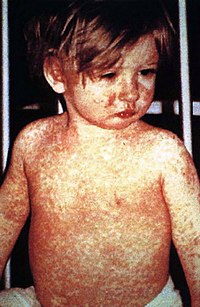
Photo from wikipedia
Chloracne is an extremely rare acneiform eruption triggered by exposure to chemicals containing halogenated aromatic hydrocarbons. Unlike acne, which tends to affect areas with a high concentration of sebaceous glands,… Click to show full abstract
Chloracne is an extremely rare acneiform eruption triggered by exposure to chemicals containing halogenated aromatic hydrocarbons. Unlike acne, which tends to affect areas with a high concentration of sebaceous glands, the most common areas affected by chloracne are the periocular, periauricular, genital, and axillary regions. Histopathology showing characteristic loss of sebaceous glands is supportive of the diagnosis. Numerous open comedones varying in size from small to large and yellow-white inflammatory papules may be appreciated on dermoscopy. Clinicopathologic correlation is essential for clenching the diagnosis. It is important to identify the likely trigger, as avoidance of the substance is the mainstay of treatment. Therapies such as oral steroids and topical and oral retinoids have not demonstrated efficacy in the treatment of chloracne. We present a case of localized chloracne in a Black patient and describe the clinical, dermoscopic, and histopathologic findings to increase awareness of its manifestations in patients with skin of color.
Journal Title: Clinical and experimental dermatology
Year Published: 2023
Link to full text (if available)
Share on Social Media: Sign Up to like & get
recommendations!